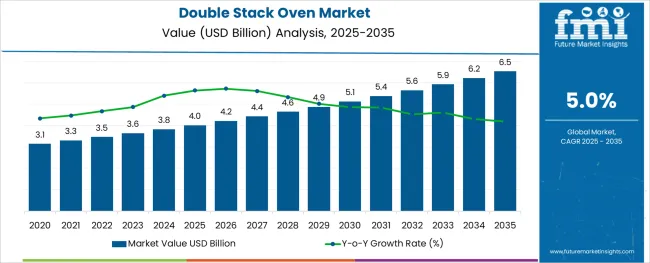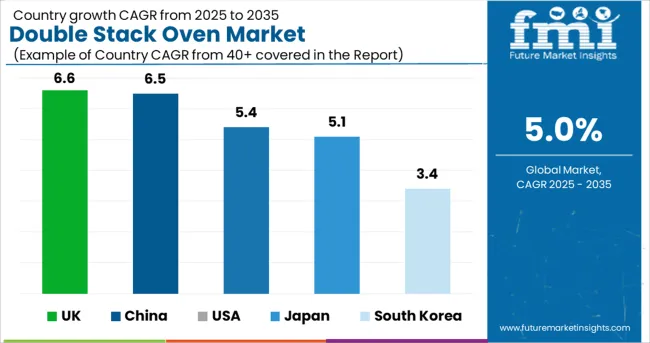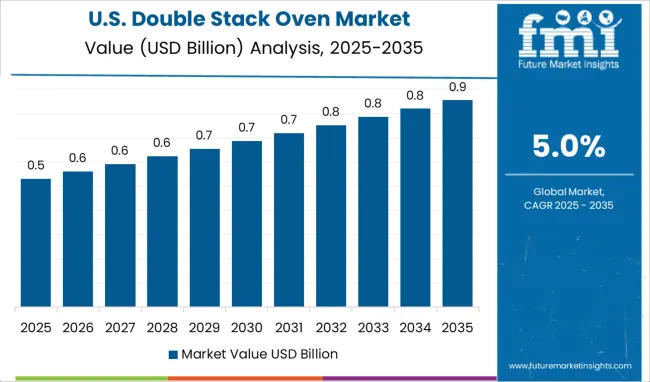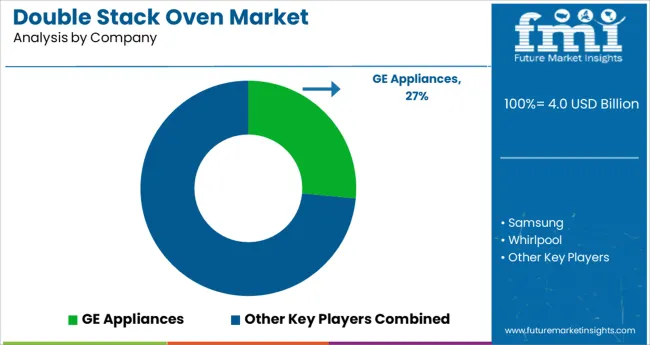The Double Stack Oven Market is estimated to be valued at USD 4.0 billion in 2025 and is projected to reach USD 6.5 billion by 2035, registering a compound annual growth rate (CAGR) of 5.0% over the forecast period.

The alginic acid market is undergoing consistent growth, propelled by rising demand from food processing, pharmaceutical formulations, and cosmetic applications. A growing focus on natural and sustainable ingredients in manufacturing processes has positioned alginic acid as a preferred biopolymer across industries.
The market is further supported by its diverse functional benefits, including water retention, gelling, and stabilizing properties, which make it indispensable in high-performance formulations. Increased regulatory acceptance of alginates as safe additives and the push towards cleaner labeling in food and personal care products have reinforced their adoption.
Ongoing innovation in extraction technologies and the utilization of algae as a renewable resource are paving the way for cost-effective production and expanded applications, ensuring sustained market expansion in the coming years.
The market is segmented by Power Type, Buyer Type, and Sales Channel and region. By Power Type, the market is divided into Electric, Liquid Propane, and Natural Gas. In terms of Buyer Type, the market is classified into Commercial Buyers and Household Buyers. Based on Sales Channel, the market is segmented into Food Equipment Specialty Retailers, Brand Franchised Stores, Modern Trade, eCommerce Platforms, and Others. Regionally, the market is classified into North America, Latin America, Western Europe, Eastern Europe, Balkan & Baltic Countries, Russia & Belarus, Central Asia, East Asia, South Asia & Pacific, and the Middle East & Africa.
When segmented by salts, sodium alginate is expected to command 27.5% of the market revenue in 2025, marking it as the leading subsegment in this category. This leadership has been driven by its superior solubility, ease of incorporation into formulations, and versatility in a wide range of applications.
Its ability to form stable gels and maintain viscosity under varying conditions has made it highly sought after in both food and pharmaceutical sectors. Manufacturers have prioritized sodium alginate due to its consistent performance, cost-effectiveness, and regulatory acceptance, which have collectively strengthened its position.
The segment’s prominence has also been enhanced by its adaptability to evolving consumer preferences for plant-derived and sustainable ingredients, reinforcing its market share.
Segmented by end user industry, the food industry is projected to hold 33.0% of the market revenue in 2025, positioning it as the most prominent sector. This dominance has been shaped by the industry’s increasing reliance on alginic acid and its derivatives to deliver desirable textures, stabilize emulsions, and improve shelf life of processed foods.
As consumer demand for clean label and natural additives has intensified, the food sector has responded by integrating alginates into bakery, dairy, and confectionery products. Enhanced production efficiency and compliance with food safety standards have further encouraged widespread use.
The segment’s leadership has also been supported by product differentiation strategies where alginates contribute to premium quality and innovation, securing their role in modern food formulations.
When analyzed by functionality, thickening agents are forecast to account for 29.0% of the market revenue in 2025, establishing themselves as the dominant functional category. This preeminence has been underpinned by the growing need for consistent texture and viscosity in a wide array of end products.
Alginic acid’s natural origin and high efficiency in creating uniform, stable thickness without altering taste or color have solidified its appeal. The demand for thickeners in both edible and topical applications has expanded, with manufacturers leveraging its rheological properties to meet performance and regulatory requirements.
The functionality’s leading share has also been reinforced by the ability to deliver cost savings through lower dosages and its compatibility with other ingredients, securing its position as an indispensable component in formulation strategies.
Asia Pacific's double oven market is expected to be the fastest-growing market during the forecast period.
Rapid technological advancements coupled with infrastructural developments are expected to surge the growth of the double-stack oven market in the Asia Pacific. Of all the sectors, it is expected that the seafood market in the Asia Pacific is expected massively contribute to the growth of the Asia Pacific double-stack oven market.
Seafood restaurants across the Asia Pacific are increasingly making use of double-stack ovens to serve customers within no time, and this definitely shows positive trends pertaining to the Asia Pacific market.
Europe: One of the leading markets for quick service restaurants, which represents a lot of scope for the double stack oven market
The Europe quick service restaurant is valued at close to USD 4 billion as of 2025. The convenience, good taste, and growing focus on serving nutritious food are expected to surge the market going ahead.
However, if we talk in terms of Europe's double-stack oven market, the growth of quick-service restaurants is expected to surge the double-stack oven market in Europe.
The reason is that these provide heating solutions for food, and within a short span of time, the customer gets to consume fresh food owing to the adoption of double-stack ovens.
On comparing the historical CAGR with the anticipated CAGR, we get to see that the double-stack oven market is in for growth. While the historical CAGR for the double-stack oven market was 4.6%, the anticipated CAGR for the forecast period is 5%.
Increased consumption of fast food, coupled with rapid urbanization, which has led to lifestyle changes are some of the factors why the market is anticipated to grow during the forecast period.
Ability to cook two different dishes at different temperatures
The presence of a double-stack oven allows for cooking two different dishes at different temperatures. This gives the customers to use both stacks at their convenience.
High Capacity
As compared to single ovens, double-stack ovens provide a much higher capacity. This allows the customers to place even more than two dishes in certain cases. Additionally, the double-stack ovens also have the ability to skip the bottom storage stack for accommodating more items in a single go.
High price
The price of the double stack oven is quite high, as a result of which not many individuals can afford to buy them.
Difficulty in opening the bottom oven
The users are of the opinion that they generally experience difficulty in opening the bottom oven, and many of them also find it difficult to load dishes in the bottom oven. This might hamper the sales of the double-stack ovens.

The China double stack oven market is expected to grow at a CAGR of 6.5% during the forecast period. The China market holds a valuation of USD 4 million as of 2025, and by 2035 the market is expected to reach a valuation of USD 893.25 million.
The historical CAGR (2020 to 2025) of the double-stack oven market in China was 4.6%. A jump from 4.6% to 6.5% shows that China market has a lot to offer.
The smart kitchen appliances market is expected to grow at a CAGR of around 22.3% during the forecast period. The double-stack oven forms a considerable share of the smart major kitchen appliances market. This is expected to surge the sales of double-stack ovens in China.

The USA double-stack oven market is expected to grow at a CAGR of 5.4% during the forecast period. In 2025, the double stack oven market in the USA is valued at USD 6.5 million, and by 2035, the market is expected to reach a valuation of USD 1488.75 million.
The historical CAGR (2020 to 2025) for the market was 5.3%, and the anticipated CAGR during the forecast period is 5.4%. Though there is hardly any difference, the surge in the growth rate of certain sectors which require double-stack ovens is something that the USA double-stack oven is optimistic about.
The fast food service market in the USA is valued at USD 4 billion as of 2025 and is expected to grow at a CAGR of 4.6% during the forecast period.
Fast food is something that is served as well as consumed on an immediate basis. In order to maintain the freshness of the food, the restaurant owners make use of double-stack ovens to accommodate more food at a given point in time. This is well expected to increase the sales of double-stack ovens in the USA.
The double-stack oven market in Japan is valued at USD 147.935 million as of 2025. The market is expected to grow at a CAGR of 5.1% during the forecast period, and by 2035, the market is expected to reach a valuation of USD 3.1 million. The historical CAGR (2020 to 2025) of the market was 4.6%.
The frozen desserts market in Japan is valued at around USD 4.3 billion as of 2025 and is expected to grow at a CAGR of nearly 6.2% during the forecast period.
Frozen desserts are meant to be consumed on an immediate basis, and there are a few desserts that need to be heated before consumption. The end users generally make use of ovens before consuming them. This is well expected to increase the application of double-stack ovens during the forecast period.
The UK double-stack oven market is expected to reach a valuation of USD 45 million by 2035. The market is expected to grow at a CAGR of 6.6% during the forecast period, and as of 2025, the double-stack oven market in the UK is valued at USD 196.95 million.
The historical CAGR (2020 to 2025) was 4.6%. A jump from 4.6% to 6.6% truly reflects the potential of the market in the UK.
In 2024, the UK bakery products market was valued at nearly USD 146.2 billion. The growing bakery products market indicates the fact that the bakery business is thriving, and while preparing cakes, muffins, etc. the bakers do make use of double-stack ovens, thereby focusing on both taste and number of cakes.
The South Korean double-stack oven market is expected to grow at a CAGR of 3.4% during the forecast period. The double-stack oven market in South Korea is valued at USD 42.59 million in 2025, and by 2035, it is expected to reach a valuation of USD 148.875 million.
The historical CAGR (2020 to 2025) for the market was 3.9%.
The popcorn market in South Korea is valued at USD 126.2 million as of 2025. Be it multiplexes, restaurants, residential places, etc., the double stack oven are used for preparing popcorn. Apart from popcorn, these are used for a variety of other purposes as well like for heating fast food, sweet dishes, etc. This presents a huge opportunity for the South Korean double-stack oven market.
The electric segment is expected to have the highest market share. The segment is expected to grow at a CAGR of 5.3% during the forecast period, and the historical CAGR (2020 to 2025) for the segment was 5%.
The double-stack electric oven segment is expected to dominate the segment as the manufacturers are specifically into developing energy-efficient solutions in the electric segment. This would ensure that much less energy is consumed.
The commercial segment is expected to have the highest market share. The segment is anticipated to grow at a CAGR of 4.7% during the forecast period, and the historical CAGR for the segment was 4.4%.
The commercial segment usually involves bulk purchases. Apart from that, companies are frequently in need of these machines as there are frequent cases of companies expanding their offices to new regions, where the companies might be requiring more of these machines.
The start-up companies operating in the double-stack oven market are making the best use of technology as well as Research and Development for developing the best quality ovens to serve their customers.
Tovala is a food-tech company that was founded in 2020. It has been offering meal service combined with a countertop smart oven. The company has developed a meal system that combines an internet-connected countertop steam oven capable of multi-step cooking with meals, making dinner preparation simple, and enabling busy people to get access to an effortless way of eating delicious meals.
In February 2024, Tovala closed a Series C funding of USD 30 million. The funding round was led by Left Lane Capital, accompanied by Comcast Ventures, Finistere Ventures, and Pritzker Group.

The key players in the double-stack oven market are investing in activities pertaining to mergers and acquisitions. The steps are being taken to surge the market share and to make use of certain technologies, which were otherwise unavailable to them.
Apart from that, the key players are also developing strategic collaborations with players from other sectors, to focus more on manufacturing top-quality spare parts pertaining to double-stack ovens.
Some of the recent developments are:
GE Appliances has always believed in making good things for life. They create, think, and make by believing that anything is possible and that there is always a better way. The diverse background of employees working for GE Appliances introduces a vibrant culture in the organization.
Since 1907, the company has been delivering innovative quality products that are trusted in half of the USA. They have always maintained a ‘zero distance’ approach to be closer to the customers and business owners. The belief is to build great appliances and great communities.
Owing to its excellent work culture, on 23rd August 2025, GE Appliances earned the 2025 great place to work certification.
Samsung has always provided solutions that constantly reinvent the future. They have created a culture of infinite possibilities, where the company takes no time to convert a brilliant idea into a final electronic product.
The company has always committed to complying with local laws and regulations, as well as applying a strict global code of conduct to its employees. In the era of high competition among various players, Samsung continues to train its employees to follow ethical practices, and operate monitoring systems.
On 27th October 2025, Jay Y. Lee was appointed as the Executive Chairman of Samsung Electronics.
Bosch has adopted an ownership structure, which guarantees entrepreneurial freedom to each and every employee who works for the company. The company has mainly been into providing mobility solutions, industrial technology, consumer goods, and energy and building technology.
Rapid reactions, innovations, and the digital supply chain are becoming increasingly important. The company has been seizing the opportunities to position Bosch as a leader in the IoT.
On 19th July 2025, Bosch established a sector board for the Mobility Solutions business sector.
The global double stack oven market is estimated to be valued at USD 4.0 billion in 2025.
It is projected to reach USD 6.5 billion by 2035.
The market is expected to grow at a 5.0% CAGR between 2025 and 2035.
The key product types are electric, liquid propane and natural gas.
commercial buyers segment is expected to dominate with a 61.0% industry share in 2025.






Full Research Suite comprises of:
Market outlook & trends analysis
Interviews & case studies
Strategic recommendations
Vendor profiles & capabilities analysis
5-year forecasts
8 regions and 60+ country-level data splits
Market segment data splits
12 months of continuous data updates
DELIVERED AS:
PDF EXCEL ONLINE
Double Zipper Bags Market Size and Share Forecast Outlook 2025 to 2035
Double End Truck Wrench Market Size and Share Forecast Outlook 2025 to 2035
Double Hung Windows Market Size and Share Forecast Outlook 2025 to 2035
Double Coated Film Tapes Market Size and Share Forecast Outlook 2025 to 2035
Double Decker Roll Forming Machine Market Size and Share Forecast Outlook 2025 to 2035
Double Sided Tapes Market Size, Share & Forecast 2025 to 2035
Competitive Overview of Double Decker Roll Forming Machine Market Share
Double Seam Bowl Market
High Power Double-Clad Fiber Bragg Grating Market Size and Share Forecast Outlook 2025 to 2035
Stacking Machine Market Size and Share Forecast Outlook 2025 to 2035
Stack And Nest Containers Market Size and Share Forecast Outlook 2025 to 2035
Stackable Beaker Market Size and Share Forecast Outlook 2025 to 2035
Stackable Plastic Trays Market Size, Share & Forecast 2025 to 2035
Stackable Container Market Size and Share Forecast Outlook 2025 to 2035
Stacker Crane Market Growth – Trends & Forecast 2025 to 2035
Stacker Truck Market
Can Stack Motors Market Size and Share Forecast Outlook 2025 to 2035
Can Stack Stepper Motors Market Forecast and Outlook 2025 to 2035
ESD Stackable Box Market Trends & Industry Analysis 2024-2034
Reach Stacker Market Analysis - Size, Share, and Forecast Outlook 2025 to 2035

Thank you!
You will receive an email from our Business Development Manager. Please be sure to check your SPAM/JUNK folder too.
Chat With
MaRIA